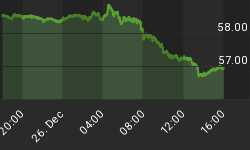Continuing my Elliott Wave series, I am going to be writing about the basics of Elliott Wave (EW). I want to keep this as simple as possible, because it is simple. The other objective I have for this series, is to make it relevant to trading. This is not for the academician, this is for the trader. I will examine how EW analysis can be used to project turning points in the market.
Wave 4 is the second corrective wave in an impulsive move. After a strong Wave 3, traders will begin to take profits thereby initiating a profit-taking correction (W4). Wave 4 can be a simple ABC (Zig-Zag) correction or a complex correction. If a correction goes past a simple ABC correction, I will just refer to it as a complex correction. I don't find it useful sitting around and trying to put a count on a complex correction. The simple ABC Zig-Zag can be either 3, 3, 5 or 5, 3, 5 in its structure. The most common structure I see is the 3, 3, 5.
There are a couple of rules/guidelines that apply to W4's. The principle of alternationstates that if Wave 2 is a simple correction, then Wave 4 will be complex; and vice versa. The rule that applies to Wave 4 is that "Wave 4 cannot enter into the territory of Wave 1". In highly leveraged, volatile markets like ES, some overlap is allowed by AdvancedGET (17% default), and some traders have restated the rule that "Wave 4 cannot close within Wave 1". The most useful Fibonacci relationship for projecting the end of Wave 4 is the retracement of Wave 3. There are otherFibonacci relationships that are used, but I find these the most useful on a day-to-day basis. I like to keep things simple, so I won't cloud the simple with a lot of trivia that I don't use. The Fibonacci levels that I use for projecting W4 are the 38.2%, 50%, and 61.8% retracements of Wave 3.

How about a couple real-life examples of Wave 4's. The first example is the major correction that took place in the summer of 2009. This was a large correction and was a very tradable move. As Wave A unfolded and began to look impulsive to me, I projected that we would be having a Wave B and Wave C to follow to lower lows. I projected Wave B to the tick, and I called the end of Wave 4 the day after it ended. This was all based on an understanding of the structure of a W4. All this was at a time when the trading world was in love with a H&S formation, and were calling for a market top. I called for a failed H&S based on EW analysis. A few days later I projected an extended Wave 5 that would carry to a minimum of 1126.25. That was met with a little ridicule.

Here is another archive where I make one of my successful calls based on an understanding of Wave 4. It is a larger picture of the W4 above and my actual posting where I make the call that W4 is over. The instructive part of the posting below is the rationale based on W4 guidelines that I used to make the call. The Head & Shoulder formation that everyone was talking about is obvious on this chart.

And lastly, I have an intraday chart where an understanding of W4 was useful to me in my trading. This was a classic setup for trading W5. I was hoping that W5 would "be all it could be" but unfortunately it turned into an ending diagonal and didn't make a new low. It was still a good trade and is a very typical W4 that is worth studying.

My next lesson will discuss Wave 5.
If you like what you see here, wait to see how MortiES's analysis can assist you in your everyday investing or trading strategy! Go ahead., Click on "Subscribe to MortiES Premium" and give it a try! I am offering a 30 day free trial period.
















